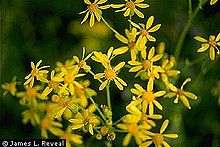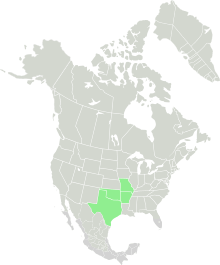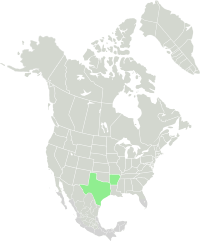Senecio ampullaceus
Senecio ampullaceus, also known as Texas ragwort,[1] Texas squaw-weed, Texas groundsel,[3] and Texas butterweed,[4] is a species of Senecio in the family Asteraceae, receiving its Latin name ampullaceus from its flask shaped flower-head.[5] It is recommended for landscape use in its native Texas.[6]
| Senecio ampullaceus | |
|---|---|
 | |
| Texas ragwort | |
| Scientific classification | |
| Kingdom: | Plantae |
| Clade: | Tracheophytes |
| Clade: | Angiosperms |
| Clade: | Eudicots |
| Clade: | Asterids |
| Order: | Asterales |
| Family: | Asteraceae |
| Genus: | Senecio |
| Species: | S. ampullaceus |
| Binomial name | |
| Senecio ampullaceus | |
 | |
| Current range of S. ampullaceus. | |
Description
The seedlings of S. ampullaceus often have a purplish color on the undersides of their leaves in the winter, especially along their midrib.[3] Flowering in early–mid spring,[7] Texas ragwort is a tall annual,[8] growing to from 20 centimeters (7.9 in) to 80 centimeters (31 in) tall and similar to S. quaylei.[7]
Stems and leaves: The leaves with broadly winged leaf stalks, grow from single stems; the nodes between leaves getting shorter and shorter higher on the stem. Ovate leaves with pointed tips 3 centimeters (1.2 in) to 10 centimeters (3.9 in) long by 1.5 centimeters (0.59 in) to 4 centimeters (1.6 in) wide with tapered bases. Leaves at the lower portion of the plant have more teeth on their edges than the leaves at the upper portion of the mature plant.[7]
Stems and leaves are covered loosely and unevenly with a mat of fine hairs, occasionally having no hairs.[7]
Flowers: Flowering stalks have 10 to 30 flower heads which as a group make a flat top to the whole plant. Each flower head is surrounded by 2 to 8 bractlets or mini-leaves, each 1 millimeter (0.039 in) to more than 2 millimeters (0.079 in). Approximately 13 green to grayish bracts, 7 millimeters (0.28 in) to 10 millimeters (0.39 in) long surrounding 8 ray florets and an 8 millimeters (0.31 in) to 10 millimeters (0.39 in) corolla.[7]
Fruits: One seeded fruits with rigid pappus.[7]
Roots: Roots relatively thin and branching.[7]
Distribution
S. ampullanceus prefers altitudes of 100 meters (330 ft) to 800 meters (2,600 ft) in open sandy or disturbed sites.[7]
Native:

or
Current:
Varieties or subspecies which are synonyms
- Senecio ampullaceus var. floccosus Engelm. & A. Gray
- Senecio ampullaceus var. glaberrimus Engelm. & A. Gray[7][12]
References
- Natural Resources Conservation Service (NRCS). "PLANTS Profile, Senecio ampullaceus Hook". The PLANTS Database. United States Department of Agriculture. Retrieved 2008-04-08.
- Integrated Taxonomic Information System Organization (ITIS). "Senecio ampullaceus Hook". Integrated Taxonomic Information System on-line database. Retrieved 2008-04-08.
- Texas A&M University. "Texas Groundsel, Texas Squaw-Weed" (PDF). Archived from the original (PDF) on October 17, 2006. Retrieved 2008-04-10.
- Peterson Field Guide, Theodore F. Niehaus (1998) [1984]. "Tall-stemmed Butterweeds". A Field Guide to Southwestern and Texas Wildflowers. The Peterson Field Guide Series. Illustrations by Charles L. Ripper. New York, New York 100003: Houghton Mifflin Company. pp. 449 pages. ISBN 0-395-93612-8. Retrieved 2008-04-09.CS1 maint: location (link)
- Holloway, Joel Ellis; Neill, Amanda (2005). "Section 36". A Dictionary of Common Wildflowers of Texas & the Southern Great Plains. TCU Press. p. 2005. ISBN 0-87565-309-X. Retrieved 2008-04-08.
- Federal Highway Administration (2005-07-11). "Native Plants for Landscape Use in Texas". State Plant Listings. United States Department of the Interior. Archived from the original on 2008-07-23. Retrieved 2008-04-08.
- Flora of North America. "32. Senecio ampullaceus Hooker". 20: Page 548, 561. Retrieved 2008-04-08. Cite journal requires
|journal=(help) - University of Texas at Austin. "Senecio ampullaceus". Image Archive of Central Texas Plants. University of Texas at Austin. Retrieved 2008-04-08.
- Flora of Missouri. "Senecio ampullaceus Hook". 2: Page 1654. Retrieved 2008-04-08. Cite journal requires
|journal=(help) - Walter C. Holmes; Jason R. Singhurst; Steve G. Powers (September 2006). "SENECIO AMPULLACEUS (ASTERACEAE): A WEST GULF COASTAL PLAIN ENDEMIC NEW TO OKLAHOMA" (PDF). Phytologia. 88 (2): 193–195. Retrieved 2008-04-08.
- Ozarks Regional Herbarium (2002-06-26). "ADVENTIVE TAXA OF MISSOURI". CONTRIBUTIONS OF THE OZARKS REGIONAL HERBARIUM. Missouri State University. Retrieved 2008-04-08.
- Missouri Botanical Garden. "Senecio ampullaceus Hook". Missouri Botanical Garden Press. Retrieved 2008-04-08.
External links

